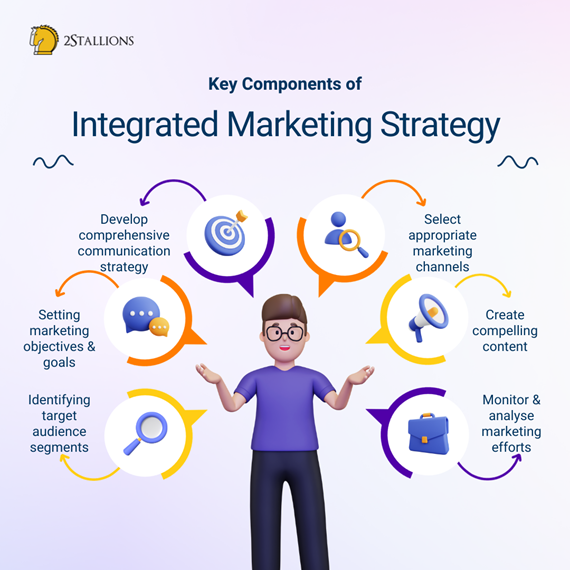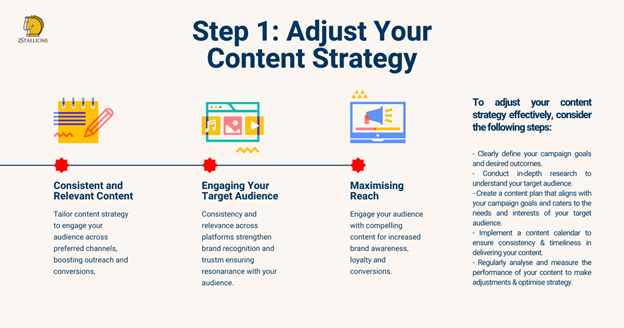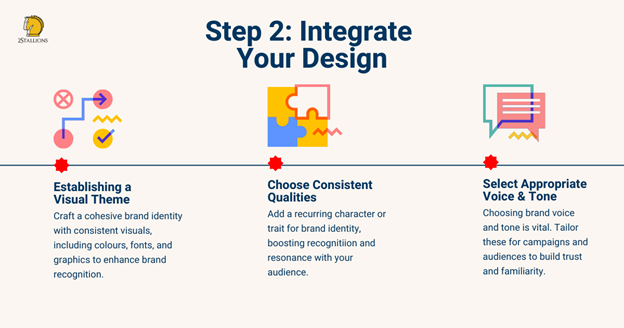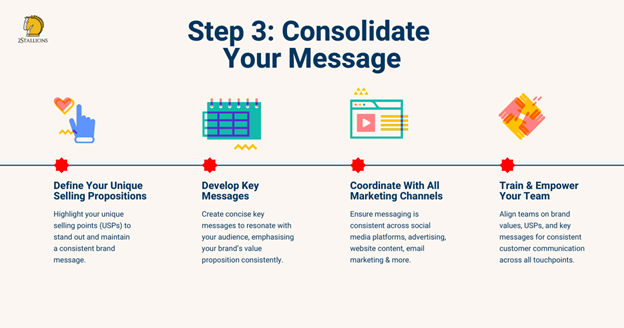Content
SHARE

In the past month, we've delved into the intricate world of crafting effective Integrated Marketing Communications (IMC) strategies. As we've ventured into this multifaceted realm, we've uncovered various essential facets that contribute to the success of IMC campaigns. The landscape is complex, involving numerous variables, including target audiences, communication channels, reach, and overarching strategy.
However, taking a step back and briefly recap what we've explored before venturing further into this intricate subject is prudent. Integrated Marketing Communications, often called IMC, is a dynamic and comprehensive approach to marketing. It's a methodology that recognises the significance of consistency and synergy across all aspects of your marketing efforts.
In other words, IMC ensures that your brand message and identity are cohesive, regardless of the communication channel. One of the central tenets of IMC is aligning your brand's messaging with your target audience's preferences, behaviours, and expectations. This alignment is achieved by carefully selecting the most suitable communication channels and tailoring your content and design to resonate with the intended recipients.
Furthermore, integrating design, maintaining a consistent voice and tone, and highlighting your Unique Selling Propositions (USPs) contribute to a successful IMC strategy. Throughout our discussions, we have emphasised the importance of a standardised yet adaptable content strategy that transcends individual platforms, ensuring that your core message remains consistent.
In essence, the ultimate goal of IMC is to create a recognisable and reliable brand presence capable of standing out across diverse marketing channels. Now, as we prepare to delve deeper into the intricacies of IMC, it's crucial to bear in mind the principles we've covered. These foundational concepts will continue to guide our exploration as we navigate the nuanced terrain of integrated marketing communications strategies.
[thrive_leads id='8298′]
What Is an Integrated Marketing Communications Strategy?
An integrated marketing communications strategy refers to a comprehensive and strategic approach to marketing that strives to establish consistent messaging and branding across various marketing channels. It is a unified and synchronised effort to ensure that all communication and marketing efforts work together seamlessly to deliver a cohesive and impactful message to the target audience.
An integrated marketing communications strategy aims to eliminate disjointed brand experiences and create a consistent brand message that resonates with the customer. Companies can ensure that their messaging is consistent and aligned with their overall marketing strategy by integrating all communication channels, such as advertising, public relations, direct marketing, content marketing, and social media.
An integrated approach guarantees consistency in messaging and branding by orchestrating all marketing activities. This method ensures that every touchpoint with the customer conveys a consistent message and experience, helping to build trust and familiarity with the brand. It also increases the likelihood of customer engagement and conversion rates, as potential customers are more likely to respond positively to a consistent and meaningful brand message across various channels.
Implementing an integrated marketing communications strategy offers several benefits. It enhances customer engagement by delivering consistent and relevant messaging through various communication channels, making it more likely for customers to interact with the brand. A seamless and consistent customer experience also contributes to stronger brand loyalty, as customers feel more connected to a brand with a coherent and unified message.
Additionally, an integrated approach often leads to improved return on marketing investment, allowing for more efficient targeting of potential customers and reducing customer acquisition costs. An integrated marketing communications strategy is a strategic approach that ensures consistency in messaging and branding across various marketing channels. By implementing this approach, companies can achieve increased customer engagement, stronger brand loyalty, and improved returns on their marketing investments.
Check our previous article to catch up on the steps to creating one. All caught up? Let's dive in.
Benefits of IMC
The benefits of an integrated marketing communications (IMC) approach for businesses are numerous. Firstly, IMC helps create a consistent brand message across all communication channels, ensuring the brand's values and attributes are accurately conveyed to the target audience. This consistency in messaging builds brand recognition, making it easier for customers to identify and remember the brand.
Furthermore, IMC helps build trust with the audience. By delivering a cohesive message through various channels, companies can establish themselves as reliable and credible in the eyes of the customer. This trust increases customer loyalty as customers feel more connected to a brand that consistently delivers on its promises.
Implementing an IMC approach also saves time and money for businesses. By streamlining marketing efforts, companies can avoid needing multiple agencies or vendors, reducing costs and eliminating the inconsistencies arising from working with different partners. This unified approach also saves time, as marketers can focus on developing and executing campaigns instead of managing multiple communication channels separately.
An integrated marketing communications strategy offers businesses the benefits of a consistent brand message, increased brand recognition, improved customer trust and loyalty, and savings in both time and money. By adopting this strategic approach, companies can enhance their marketing efforts and achieve a stronger and more cohesive brand presence in the marketplace.
How to Develop Your IMC Campaigns
Developing campaigns is all part of digital marketing; it's how we reach and communicate with our audiences. Campaigns can be built around certain products to enhance sales or entire brands, raising awareness and boosting audience loyalty and reach. In a nutshell, campaigns are a consolidated attempt to reach a target audience for a targeted purpose. 'Regular' marketing strategies use campaigns for just that purpose.
Now, let's assume you're developing your IMC strategy – you're establishing what integrated, consolidated message you want to reach your audience with, and you've selected your primary and secondary channels. You want to tap into the advantages of your newly minted, integrated marketing communications strategy, so what's next?
Step 1: Adjust Your Content Strategy
Evaluating your content strategy is crucial in laying the foundation for an effective Integrated Marketing Communications (IMC) campaign. Begin by asking yourself a few key questions: Have you charted out your content plan for the coming months? How about next year? Is your content calendar structured with a logical progression from one piece of content to the next?
One of the fundamental aspects of building successful IMC campaigns is ensuring that your content strategy seamlessly facilitates message integration. Many companies, out of convenience or habit, opt for a one-size-fits-all approach to content creation across their various communication channels. While this is a common practice, it's not always the most effective one. Creating identical content for every channel overlooks a fundamental truth: no two platforms are identical.
Each social media platform caters to a different demographic and audience with unique expectations and preferences. Recognising these distinctions is essential. Here's where IMC comes into play. While you should adapt your content to suit each platform and its audience, your overarching brand message must remain consistent. The key lies in adjusting to your content strategy, enabling you to deliver a unified yet tailored approach.
This approach ensures that your content remains consistent and relevant, effectively resonating with your target audience across diverse platforms, and ultimately drives the success of your integrated marketing communications campaign. Essentially, it's about balancing tailoring content for specific channels while maintaining the core message reflecting your brand's identity and values.
This approach amplifies your brand's resonance, making it more compelling and relatable to broader audiences. The art of harmonising diverse voices into a single, powerful chorus defines your brand.
Step 2: Integrate Your Design
Picture this: a flash of yellow against red, and you immediately think of McDonald's. A bottle with white against red and the name Coca-Cola pops into your head. If I say, "Just do It," you'll instantly associate it with Nike. This rapid brand recognition doesn't happen overnight; it's the product of meticulous design work and consistent messaging. To effectively engage with your audience and maintain a strong brand identity, your visual content should reflect your brand image and evoke a connection.
Furthermore, this consistency should extend across all platforms – from your website and social media to your physical events. Every piece of content you share should undeniably look like your brand's creation, and this is where your Integrated Marketing Communications (IMC) strategy comes into play. Incorporating design into your IMC strategy ensures a cohesive and visually appealing brand presence. The foundation is establishing a consistent visual theme encompassing colours, fonts, and graphics.
Additionally, embracing a recurring character or distinctive quality further bolsters brand recognition. It's not just about what you say but how you say it, as selecting the right voice and tone contributes to the resonance of your message. By harmonising design, character, voice, and tone within your IMC campaigns, you forge a powerful brand identity that resonates with your target audience and propels your campaign objectives forward. This holistic approach transforms your brand into a beacon of recognition and trust in a sea of visual content, making your message unforgettable.
Step 3: Consolidate your Message
Congratulations on your robust content strategy and your design team's creative prowess – it's all shaping up splendidly. However, one vital aspect should be in the spotlight: your words. Are they conveying your message clearly and consistently across all platforms? If the answer is a resounding "yes," fantastic! But it's not just about the words; it's about the story they tell, whether that's through text, images, or silent videos.
Even if your message is conveyed in silence, it must remain unswervingly clear and uniform across all your publication platforms. In the marketing world, even the slightest tweak or format change can unintentionally alter the core message of your content. So, it's crucial to be vigilant, ensuring that your message stays unwaveringly intact when transitioning between different media formats.
By unifying your messaging, you're setting the stage for a unified and powerful brand experience tailored to your target audience. A consistent representation of your brand's values, unique selling points (USPs), and critical messages across diverse channels serves several essential functions. It establishes and reinforces your brand identity, cultivating trust with your audience and setting you apart from competitors in the market.
While your strategy and creative elements are essential, the words driving your campaign are your message's linchpin. Maintaining their clarity and consistency across all channels ensures a memorable and trust-building brand experience. This cohesion is the cornerstone of successful marketing, enabling your brand to flourish and stand out in a crowded marketplace.
Coca-Cola Integrated Marketing Communications Campaign
One successful example of an integrated marketing communications (IMC) strategy is the "Share a Coke" campaign by The Coca-Cola Company. The company's marketing objective was to personalise their brand and strengthen their connection with consumers. In this campaign, Coca-Cola replaced their iconic logo on bottles and cans with famous names and terms, such as "Share a Coke with Sarah" or "Share a Coke with Best Friend."
This personalised approach aimed to resonate with consumers and make the brand feel more relatable and inclusive. To execute this IMC strategy, Coca-Cola utilised various tactics. They launched a widespread advertising campaign across multiple channels, including television, print, billboards, and digital platforms. This ensured a consistent message and broad reach across different touchpoints.
Additionally, Coca-Cola encouraged social media engagement by inviting people to share their personalised Coke bottles using the hashtag #ShareACoke. This created a sense of community and allowed the campaign to extend its reach organically. The campaign's success can be attributed to its integrated approach, as the messaging and personalisation are carried through all marketing channels.
By combining traditional and digital marketing efforts, Coca-Cola was able to effectively engage its target audience, generate brand buzz, and increase consumer loyalty. The "Share a Coke" campaign exemplifies the power of an integrated marketing communications strategy in achieving marketing objectives and creating widespread brand awareness.
Summing Up
Imagine your brand as a unique fingerprint in the digital landscape – easily recognisable, distinctive, and consistent. That's the essence of the marketing holy grail, and it's an achievement possible through a well-executed Integrated Marketing Communications (IMC) campaign. The heart of IMC lies in the ability to make your brand unmistakable across all platforms. From a fleeting glimpse on a social media feed to a glance at a billboard, your brand and its core message should resonate without hesitation.
This level of recognition is the cornerstone of successful marketing, and it's attainable with the right IMC strategy. However, it's essential to remember that your IMC campaign's effectiveness hinges on your content, design, and outreach methods. While it's vital to tailor your approach to match each platform's unique audience, your brand's identity and core message should remain unwaveringly consistent across all channels.
In other words, your content strategy should reflect this cohesive outlook. Whether engaging with Facebook, LinkedIn, or X (formerly Twitter), you must adapt your content to fit each platform's format and character limits. However, your brand's voice, tone, and core message should be uniform. Suppose you're ready to embark on the journey of integrated marketing communications campaigns. In that case, we're here to guide you in developing a strategy and series of campaigns that bring your brand message to life on your website and social media platforms.
Get in touch with us today, and let's embark on this exciting journey together!
Originally published: 25 March, 2021
Updated: 23 September, 2023
Transform Your Digital Presence With Our Comprehensive Internet Marketing Solution, Seamlessly Integrating the Power of Omnichannel Marketing. Reach your audience where they are, delivering targeted messages across platforms for maximum impact. Elevate your brand's online strategy with our innovative approach, driving engagement and conversions like never before.
Frequently Asked Questions About Integrated Marketing Communications Campaign
What is an Integrated Marketing Communications Campaign?
An Integrated Marketing Communications (IMC) campaign is a strategic approach that ensures a consistent and unified message is communicated across multiple marketing channels. The campaign delivers a seamless and customer-centric experience by integrating various tools and mediums.
How to Do an IMC Campaign?
- Set Clear Objectives: Understand what you want to achieve, such as increasing brand awareness or sales.
- Identify Your Target Audience: Understand their demographics, preferences, behaviours, and pain points.
- Choose Communication Tools: Depending on your audience and objectives, select tools like advertising, PR, social media, and direct marketing.
- Create a Consistent Message: Ensure all communications align with a central theme or message.
- Execute Across Channels: Launch your campaign across the chosen channels.
- Measure & Evaluate: Use metrics to determine the campaign's success and adjust as needed.
What is the Purpose of an IMC Campaign?
The primary purpose of an IMC campaign is to create a unified and consistent brand message across various marketing channels. This approach amplifies the message and ensures a cohesive and harmonised user experience. IMC campaigns aim to build stronger customer relationships, increase brand loyalty, and drive desired consumer actions
What is the Difference Between an IMC Campaign and an Advertising Campaign?
An IMC campaign is a holistic approach that encompasses a range of communication tools, including advertising, PR, social media, direct marketing, and more, to deliver a consistent brand message. In contrast, an advertising campaign is focused solely on creating and distributing promotional content through specific channels, such as TV, radio, print, or digital. While advertising is a component of IMC, IMC offers a broader and more integrated strategy.
What Makes a Good IMC Campaign?
- Consistency: The campaign's message is uniform across all channels.
- Customer-Centric: It addresses the needs, preferences, and pain points of the target audience.
- Strategic Integration: Uses the strengths of each marketing tool to enhance the overall impact.
- Clear Call-to-Action: It directs the audience towards a desired outcome, be it purchasing, signing up, or any other engagement.
- Measurable Outcomes: The campaign's results can be tracked, measured, and evaluated for continuous improvement.
















